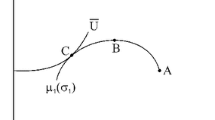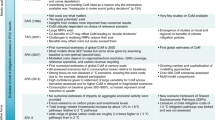Abstract
In climate change policy, adaptation tends to be viewed as being as important as mitigation. In this article we present a simple yet general argument for which mitigation must be preferred to adaptation at the global level. The argument rests on the observation that mitigation is a public good while adaptation is a private one. We show that the more one teases out the public good nature of mitigation, the lower will be the incentives to invest in the private good adaptation while it increases a policy maker’s incentives to invest in the public good mitigation. Conclusively, private adaptation yields a significant loss to global welfare. We then discuss what this implies for the current state of the art literature and what should be the lesson for future research.

Similar content being viewed by others
Notes
This attitude towards adaptation seems to be omnipresent in major international and national governments. For example, the European Union places adaptation highly on its policy agenda in the 2013 EU Strategy on Adaptation; the United Nations Environmental Program developed the National Adaptation Plan which lends support to national governments in their adaptation; and the UNFCCC promises to channel 100 billion USD to developing countries through its Green Climate Fund by 2020.
Here we follow the standard definition in Samuelson (1954) of public and private goods.
I thank Reyer Gerlagh for raising this point.
As Geir Asheim suggested, there is another way in which the model can be set up. We could instead have written \(V=NU\bigg ((1-D(M,A/N))\big (W -A/N-M/N\big )\bigg )\), which implies that as N increases we make abatement less public. The intuition is similar and the results precisely the same. Both approaches are perfectly defensible and thus it is only a matter of taste which one to use.
Using the authors’ notation and denoting by N the number of agents we re-write their pollution equation (2.1) as \(\dot{P}=NE-\alpha P\), and their instantaneous utility as \(N(\beta E-E^2/2-\gamma _2 P^2_2)\). Their model corresponds to the case of \(N=1\).
Using their notation this would yield an instantaneous utility function of \(u(C,P,D)=N(\ln (C(t)/N)-\eta (D(t)){P(t)^{1+\mu }\over 1+\mu })\) and a pollution constraint of \(\dot{D}(t)=I_D/N-\delta D\), where \(I_D/N\) implies that investments in adaptation stock are equally split over all individuals N.
The easiest way to do this is to divide their adaptation expenditure in the damage function by N.
The reason for it not being zero is because they assume limit conditions that always lead to an interior solution.
Additional points against adaptation are significant biophysical, financial and social constraints that make adaptation a particularly weak policy option. Biophysical constraints tend to be related to natural thresholds that, if once crossed (e.g. desertification), seriously inhibit both nature’s as well as mankind’s ability to adapt. Financial constraints arise if, for example, poor agricultural households cannot afford to buy the seeds that new climatic conditions require, or to insure themselves sufficiently against greater climate variability; or those needing to migrate have not sufficient funds to do so. Social limits to adaptation require us to know whether we really want to live with three meter high flood barriers around the house; or whether we believe that societies can really easily cope with large-scale climate migrants especially if there are strong cultural differences.
References
Agrawala S, Bosello F, Carraro C, De Cian E, Lanzi E et al (2011) Adapting to climate change: costs, benefits, and modelling approaches. Int Rev Environ Resour Econ 5(3):245–284
Barrett S (2008) Dikes vs. windmills: climate treatise and adaptation. Johns Hopkins University, School of Advanced International Studies, Baltimore
Bosello F, Carraro C, De Cian E (2010) Climate policy and the optimal balance between mitigation, adaptation and unavoided damage. Clim Change Econ 1(2):71–92
Bosello F, Carraro C, De Cian E (2013) Adaptation can help mitigation: an integrated approach to post-2012 climate policy. Environ Develop Econ 18(3):270–290
Bréchet T, Hritonenko N, Yatsenko Y (2013) Adaptation and mitigation in long-term climate policy. Environ Resour Econ 55(2):217–243
Brechet T, Hritonenko N, Yatsenko Y et al (2014) Domestic environmental policy and international cooperation for global commons. Technical Report, Université catholique de Louvain, Center for Operations Research and Econometrics (CORE)
Brock WA, Taylor MS (2003) The kindergarten rule of sustainable growth. Technical Report, National Bureau of Economic Research
Buob S, Stephan G (2011) To mitigate or to adapt: How to confront global climate change. Eur J Political Econ 27(1):1–16
Chamberlin J (1974) Provision of collective goods as a function of group size. Am Political Sci Rev 68(02):707–716
De Bruin KC, Dellink RB, Tol RSJ (2009) AD-DICE: an implementation of adaptation in the DICE model. Clim Change 95(1–2):63–81
De Zeeuw A, Zemel A (2012) Regime shifts and uncertainty in pollution control. J Econ Dyn Control 36(7):939–950
Ebert U, Welsch H (2011) Optimal response functions in global pollution problems can be upward-sloping: accounting for adaptation. Environ Econ Policy Stud 13(2):129–138
Ebert U, Welsch H (2012) Adaptation and mitigation in global pollution problems: economic impacts of productivity, sensitivity, and adaptive capacity. Environ Resour Econ 52(1):49–64
Farnham M, Kennedy P (2014) Adapting to climate change: equilibrium welfare implications for large and small economies. Environ Resour Econ 61:1–19
Harstad B, Lancia F, Russo A (2019) Compliance technology and self-enforcing agreements. J Eur Econ Assoc 17(1):1–29
Hope C (2006) The marginal impact of CO2 from PAGE2002: an integrated assessment model incorporating the IPCC\(\backslash\)’s five reasons for concern. Integr Assess J 6(1):19–56
Ingham A, Ma J, Ulph AM (2013) Can adaptation and mitigation be complements? Clim Change 120(1–2):39–53
IPCC (2014) Climate change 2014: synthesis report. In: Core Writing Team, Pachauri RK, Meyer LA (eds) Contribution of working groups I, II and III to the Fifth assessment report of the intergovernmental panel on climate change, IPCC, Geneva, Switzerland
Kane S, Shogren JF (2000) Linking adaptation and mitigation in climate change policy. Clim Change 45(1):75–102
Konrad KA, Thum M (2013) The role of economic policy in climate change adaptation. CESifo Econ Stud 60:32–61
Lecocq F, Shalizi Z (2007) Balancing expenditures on mitigation of and adaptation to climate change: an exploration of issues relevant to developing countries. World Bank Policy Research Working Paper, vol 4299
Mendelsohn R (2000) Efficient adaptation to climate change. Clim Change 45(3–4):583–600
Moser SC, Ekstrom JA (2010) A framework to diagnose barriers to climate change adaptation. Proc Natl Acad Sci 107(51):22026–22031
Nordhaus WD (1993) Optimal greenhouse-gas reductions and tax policy in the “DICE” model. Am Econ Rev 83(2):313–317
Olson MJ (1965) The logic of collective action: public goods and the theory of groups. Harvard University Press, Cambridge
Parry ML (2007) Climate Change 2007: impacts, adaptation and vulnerability: contribution of Working Group II to the fourth assessment report of the Intergovernmental Panel on Climate Change, vol 4. Cambridge University Press, Cambridge
Patt AG, van Vuuren DP, Frans B, Asbjørn A, Hof Andries F, Morna I, Reinhard M (2010) Adaptation in integrated assessment modeling: where do we stand? Clim Change 99(3–4):383–402
Rezai A, Van der Ploeg F (2016) Intergenerational inequality aversion, growth, and the role of damages: occams rule for the global carbon tax. J Assoc Environ Resour Econ 3(2):493–522
Samuelson PA (1954) The pure theory of public expenditure. Rev Econ Stat 36:387–389
Schumacher I (2018) The aggregation Dilemma in climate change policy evaluation. Clim Change Econ 9(03):1850008
Tsur Y, Withagen C (2013) Preparing for catastrophic climate change. J Econ 110(3):225–239
Tsur Y, Zemel A (2016) Policy tradeoffs under risk of abrupt climate change. J Econ Behav Organ 132:46–55
van der Ploeg F, de Zeeuw A (2013) Climate policy and catastrophic change: be prepared and avert risk. Technical Report. European University at St. Petersburg, Department of Economics
Yohe G, Strzepek K (2007) Adaptation and mitigation as complementary tools for reducing the risk of climate impacts. Mitig Adapt Strateg Global Change 12(5):727–739
Zemel A (2015) Adaptation, mitigation and risk: an analytic approach. J Econ Dyn Control 51:133–147
Author information
Authors and Affiliations
Corresponding author
Additional information
Publisher's Note
Springer Nature remains neutral with regard to jurisdictional claims in published maps and institutional affiliations.
For comments I thank three anonymous referees, Moutaz Altaghlibi, Geir Asheim, Ian Bateman, Partha Dasgupta, Reyer Gerlagh, Anna Lungarska, Agustin Perez-Barahona, Rick van der Ploeg, Armon Rezai, Sjak Smulders, Cees Withagen and Amos Zemel, as well as participants at the 2016 SURED conference in Banyuls-sur-Mer, 2016 EAERE conference in Zurich and the 2016 FAERE conference in Bordeaux. I also thank Dani for mitigating my adaptation problems to some of the comments that I had on this article over the years.
Rights and permissions
About this article
Cite this article
Schumacher, I. Climate Policy Must Favour Mitigation Over Adaptation. Environ Resource Econ 74, 1519–1531 (2019). https://doi.org/10.1007/s10640-019-00377-0
Accepted:
Published:
Issue Date:
DOI: https://doi.org/10.1007/s10640-019-00377-0




